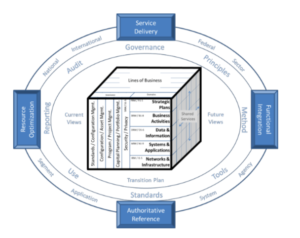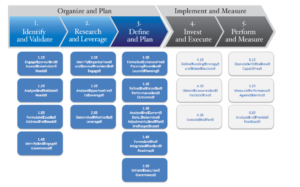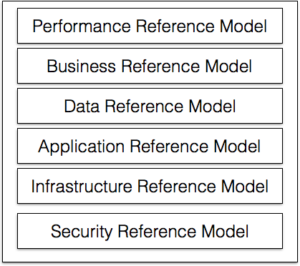Federal Enterprise Architecture Framework
Introduction
Federal Enterprise Architecture Framework is an enterprise architecture process methodology for the Federal Government of United States of America. FEA has a process for creating an enterprise architecture using the Federal Enterprise Architectural Best Practices. It has a transitional process for migrating from the current state to a future state of an enterprise.
FEA has a taxonomy for cataloging assets of the enterprise architecture. It has an approach to measuring the success of using the enterprise architecture to drive business value.
FEA-Program Management Office (FEAPMO) says FEA is :
“a common language and framework to describe and analyze IT investments, enhance collaboration and ultimately transform the Federal government into a citizen-centered, results-oriented, and market-based organization as set forth in the President’s Management Agenda. “
According to the FEA framework, an enterprise is built of segments. A segment is an enterprise line-of-business (LOB) functionality. Core mission-area and Business-services segments are two segments in the framework. A core mission-area segment is central to the mission.A business-services segment is foundational to most enterprises.
An enterprise service is a type of an enterprise architecture asset. An enterprise service is an enterprise function that goes across political boundaries. Enterprise services and segments are shared across the entire enterprise. Business-service segments encompasses only a single political organization. Enterprise services encompasses the entire enterprise.
Enterprise services, business-service and core mission-area segments are broader in focus than services found in service-oriented architectures. Segments are an organizational unit for an enterprise architecture. Enterprise architectural services are an organizational unit for technology platform implementations. The depth of organizational units for an enterprise architecture includes the business and the data architectures. Enterprise segments function at the agency level and they are defined at the enterprise level. Enterprise services and functions and are defined at the enterprise level.
FEA (Federal Enterprise Architecture Framework) has a set of reference models for describing different perspectives of the enterprise architecture. The Consolidated Reference Model (CRM) is the core of FEA framework. FEA Framework equips Office of Management and Budget (OMB) and Federal agencies with a common language and framework to describe and analyze investments. FEA framework consists of a set of interrelated reference models that describe the six architecture domains.
Collaborative Planning Methodology
The Collaborative Planning Methodology provides steps for planners to flesh out a transition strategy. The transition strategy will enable the transition from current state to future state. It is a repeatable process which consists of integrated, multi-disciplinary analysis that involves sponsors, stakeholders, planners, and implementers. The Collaborative Planning Methodology consists of two phases: Organize and Plan and Implement and Measure.
Enterprise Architects facilitate the research of other organizations and service providers. They assess whether they have similar needs across the enterprise. The enterprise architects lead the assessment of the applicability of the other organizations’ experiences and results. The plan is created based on the organizations and their needs. The architect formulates a set of findings and recommendations detailing the applicability and opportunity for leverage.
Plans and Views
The enterprise roadmap, plan and views provide a picture of the architecture. This shows what exists currently, what is planned for the future, and what the transition paths will be in Strategic, Business Services, Data and Information, Enabling Applications, Host Infrastructure and Security architecture domains.
One transition plan / two views for each architecture project are as below:
- Transition Plan
- Current Views
- Future Views
Enterprise Roadmap
An Enterprise Roadmap is created to document the current and future architecture states at a high level. The roadmap presents the transition plan for how the enterprise architecture will evolve from the present to the future . The Enterprise Roadmap combines the artifacts developed for the Enterprise Architecture’s current and future state versions. The plan developed through the Collaborative Planning Methodology creates awareness, visibility and transparency within an organization to facilitate cross-organization planning and collaboration. The plan maps strategy to projects and budget. It helps to identify the gaps between investment and execution. The dependencies and risks between projects are part of the plan.
Strategic Planning
The role of planners is to help facilitate and support a common understanding of needs based on the organization’s Strategic Plan. The strategic plan help formulate recommendations to meet the needs. It helps to facilitate the development of a plan of action in the following disciplines: mission/business, IT resources, capital, security, infrastructure, human capital, performance, and records planning.
Planners provide facilitation and integration to enable this collaborative planning discipline. They work with specialists and subject matter experts from the planning groups.The planners have an important role to play in the investment, implementation, and performance measurement activities and decisions that result from this integrated planning process.
Enterprise Architecture Program
Chief Architect manages the Enterprise Architecture Program. Chief Architect identifies EA methods and standards. He/She coordinates architecture projects and leads the configuration. Enterprise Architect in coordination with the Chief Architect, works with executives, managers, staff to identify requirements and solutions in all domains and levels of scope.
Enterprise Architects lead the development of the architecture by applying a series of analysis and planning methods and techniques. Planners work on the architecture domains and produce artifacts to capture, analyze, and visualize the plans for change. Enterprise architects facilitate the interaction with other planning disciplines. Planners develop the integrated plan and roadmap to reflect the planning activities and actions associated with them.
Enterprise Architect works on projects that deliver business, data, services, and technology architectural views. Enterprise Architect works on various enterprise architecture Segments, such as Human Resources, Financial Management, Intelligence Analysis, etc. He or She works on enterprise architectural Governance activities, to include communication and change activities.
Enterprise Architect works with clients to manage large-scale technology and business transformation initiatives through the use of FEA Framework. Enterprise Architect collaboratively defines the future state architectures for clients. He or she ensures the client’s architecture is actionable and not shelf-ware by implementing the latest thought leadership in business and information architecture. Enterprise Architect innovates and designs Enterprise Architecture solutions that can be packaged for reuse for other clients.
Business Architecture
Solution Architect works in coordination with the Enterprise Architect, works collaboratively with stakeholders to identify solutions for business and technology requirements and does analysis/documentation. Business Architect works in coordination with the Chief Architect and other architects. Business Architect works collaboratively with stakeholders to create, improve, or re-engineer business processes and identify enabling IT and does analysis and documentation. Data Architect works in coordination with the Chief Architect and other architects. Data Architect works collaboratively with stakeholders to provide technical analysis and design for data-level solution architecture projects and data-related business and technology requirements. Data Architect ensures that data solutions meet integration, interoperability, privacy requirements and does analysis and documentation.
System Architecture
Systems Architect works in coordination with the Chief Architect and other architects. System Architect works collaboratively with stakeholders to provide technical analysis and design support for systems-level architecture projects. System Architect ensures that IT systems meet integration and interoperability requirements. He or she does analysis and documentation. Infrastructure Architect works in coordination with the Chief Architect and other architects. Infrastructure Architect works collaboratively with stakeholders to provide technical analysis and design support for infrastructure-level architecture projects. Infrastructure Architect ensures that IT network and data center hosting solutions meet integration and interoperability requirements. He or she does analysis and documentation.
Security Architect works in coordination with the Chief Architect and other architects. Security Architect works collaboratively with stakeholders to provide technical analysis and design for security-related architecture projects and security or privacy-related business and technology requirements. He or She ensures that security and privacy solutions support risk mitigation plans and does analysis and documentation.
Line of Business Managers supports Enterprise Architecture program and ensures that program managers participate in architecture projects by identifying business and IT requirements for program activities. Program managers participates in architecture projects and configuration management activities. Program manager identifies business and IT requirements for program activities.
Consolidated Reference Model
The Consolidated Reference Model of the Federal Enterprise Architecture Framework (FEAF) equips OMB and Federal agencies with a common language and framework to describe and analyze investments. It consists of a set of interrelated “reference models” designed to facilitate cross-agency analysis and the identification of duplicative investments, gaps and opportunities for collaboration within and across agencies.
FEA (Federal Enterprise Architecture Framework) consist of six reference models. It has a set of reference models for describing different perspectives of the enterprise architecture. The reference models are Business Reference Model, Application Reference Model, Infrastructure Reference Model, Data Reference Model, Security Reference Model and Performance Reference Model.
Federal agencies are rated on their overall maturity levels in three main categories. The categories are Architectural Completion, Architectural use and Architectural results.
- Architectural completion shows the Maturity level of the enterprise architecture.
- Architectural use shows how effectively the agency uses its architecture to drive decision-making
- Architectural results are the benefits being realized by the use of the architecture
Office of Management and Budget (OMB) assigns each agency a success rating, based on its scores in each category and a cumulative score, as follows:
- Green—The agency rates quite well in the completion area. It also rates well in both the use area and the results area.
- Yellow—The agency rates quite well in the completion area. It also rates well in either the use area or the results area.
- Red—The agency either does not have a completed architecture and/or is not effectively using that architecture.
References:
- Federal Enterprise Architecture : The White House
- Innovate Gov
Bhagvan Kommadi, Founder, Architect Corner has around 20 years experience spanning in the creation of products & incubation of Product Startups. Bhagvan Kommadi is currently working as Rapporteur of the Smart City Governance Working Group from Architect Corner. Architect Corner is part of Digital India initiative. He is part of Ask Mentor Board mentoring startups for NASSCOM 10000 startups initiative. He has done Masters in Industrial Systems Engineering at Georgia Institute of Technology (1997) and Bachelors in Aerospace Engineering from Indian Institute of Technology, Madras (1993).












